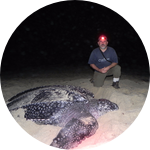About This Project
The sun bear is arguably the most poorly understood bear and one of the least known large carnivores. To shed light on its rich and complex evolutionary history, we will investigate the genetic relationships among sun bears from different portions of their range across southeast Asia. Our findings will also help determine priorities for conservation of the species, identify the origins of bear parts traded illegally, and may lead to the discovery of one or more new endangered bear subspecies.
Ask the Scientists
Join The DiscussionWhat is the context of this research?
The world’s smallest bear is also among the planet’s least understood large carnivores. Historically ranging from eastern India across southeast Asia through Myanmar, Thailand, Cambodia, Laos, Vietnam, and south to Sumatra and Borneo, the sun bear is the only bear making its home in tropical forests. Some recent studies in a few areas have begun to shed light on its ecology. Least known about sun bears however is how populations from different geographical regions relate to one another in the context of their evolutionary history. When scrutinized scientifically, other species with similar distributions have proven to be two or more very similar species. Clearer understandings of these genetic relationships can lead to the discovery of new species and change the face of conservation.
What is the significance of this project?
The Indo-Malay archipelago is home to the highest diversity and endemism of mammals on earth. These patterns in distribution of fauna and flora reflect a rich and dynamic evolutionary history. Upon purposeful scrutiny, many species of vertebrates inhabiting the archipelago's islands have proven genetically distinctive from mainland forms, including the region's carnivores. Analysis of genetic data from individual sun bears across their range will help us answer the basic question, "what is a sun bear?", a question taken for granted for many other species. A better understanding of the differences among sun bears will inform international conservation planning efforts for the species, while allowing us to develop a framework for identifying the origin of illegally-trafficked bear parts.
What are the goals of the project?
Our ultimate goals are to clarify the place of the sun bear in the context of the evolution of all living bears, and make available this information for the conservation of sun bear populations across their range. Such conservation applications include prioritizing field conservation activities, a revised assessment of the bear's status and the importance of regional populations, and assisting with international law enforcement efforts in disrupting illegal trade in live bears and bear parts. To achieve these goals we have to accomplish two key objectives. First, we need to identify the genetic characteristics of sun bears from different parts of their range. Second, we will determine the genetic relationships of sun bears from each of these different regions to all others, and overall.
Budget
Much of the initial and most challenging work needed to complete this project has already been accomplished. For example, we have already obtained genetic material from numerous bears of known origin, some of which have been rescued from the bile trade. We also have strong institutional collaborators at two different laboratories and access to key equipment, including PCR machines and a sequencing facility. What we are lacking are the supplies to process samples, extract and amplify DNA, and the cost of analyzing samples at the sequencing facility. These supplies and expenses are critical to answering the most important questions about the phylogenetic and evolutionary relationships of sun bears across southeast Asia. Previous research on other species suggest that these relationships will not only be critical to conservation planning, they may reveal new, endangered subspecies, and allow us to establish a database for identifying the origin of illegally traded bear parts.
Meet the Team
Affiliates
Anthony J. Giordano
Anthony J. Giordano is a conservation biologist and wildlife ecologist with more than 20 years of experience working in as many countries around the world. He holds a double B.Sc. from Long Island University at Southampton College in Biology (Zoology) and Environmental Science (Biology), where he completed an honors thesis on the relationship between shark communities and marine fish species diversity in Fiji, The Cook Islands, and the Kingdom of Tonga. He received his M.Sc. in conservation biology and applied ecology from Frostburg State, where he studied the feeding ecology of a reintroduced river otter population in northcentral Pennsylvania. While at Texas Tech pursuing his Ph.D. in wildlife science and management, Anthony was awarded a Fulbright Scholarship for this jaguar conservation work in the Gran Chaco. His research as a Panthera Kaplan Scholar led to the first ever formal scientific investigation of the jaguar in Paraguay and the Chaco Jaguar Conservation Project, the only long-term transboundary conservation project committed to resolving human-jaguar conflict across the vast Chaco biome. Anthony has published dozens of scientific and popular articles on wildlife ecology and conservation and conducts peer-reviews for more than a dozen scientific journals. He is the President of the Wild Felid Research and Management Association, the President Elect for the Latin American section of the Society for Conservation Biology, and serves on the Conservation Committee for the American Society of Mammalogists. Anthony is a member of the Explorer’s Club, the Sigma Xi Scientific Society, and the IUCN’s Cat, Small Carnivore, and Peccary Specialist Groups. Currently he is managing or co-managing 14 projects involving cats in 10 countries as director of S.P.E.C.I.E.S., including a fishing cat conservation effort in Bangladesh, a survey of Sri Lanka leopards with SLWCS, the first ocelot project on Trinidad, and several investigations of jaguarundi ecology.
Lab Notes
Nothing posted yet.
Project Backers
- 0Backers
- 0%Funded
- $0Total Donations
- $0Average Donation
